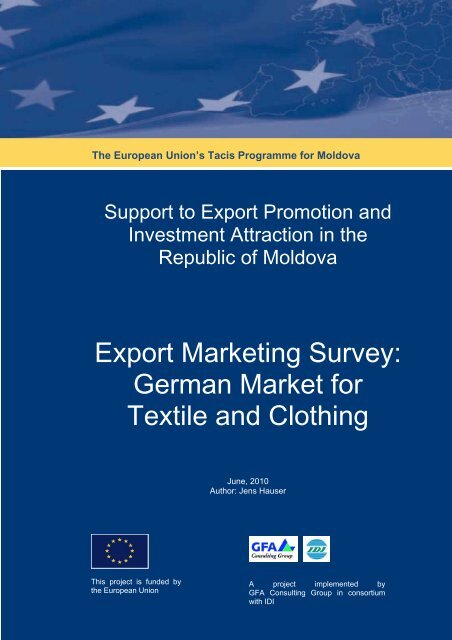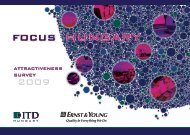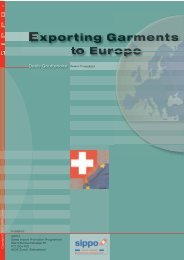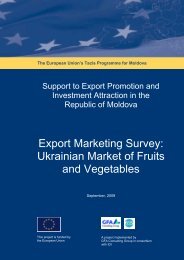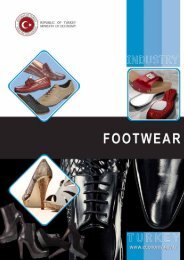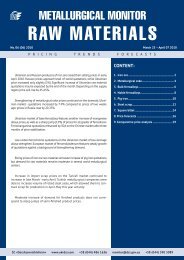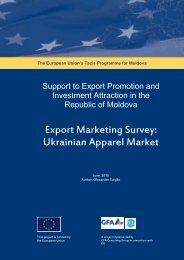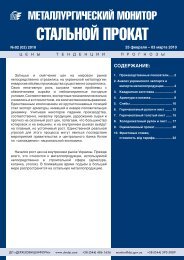Export Marketing Survey: German Market for Textile and Clothing
Export Marketing Survey: German Market for Textile and Clothing
Export Marketing Survey: German Market for Textile and Clothing
You also want an ePaper? Increase the reach of your titles
YUMPU automatically turns print PDFs into web optimized ePapers that Google loves.
The European Union’s Tacis Programme <strong>for</strong> Moldova<br />
Support to <strong>Export</strong> Promotion <strong>and</strong><br />
Investment Attraction in the<br />
Republic of Moldova<br />
<strong>Export</strong> <strong><strong>Market</strong>ing</strong> <strong>Survey</strong>:<br />
<strong>German</strong> <strong>Market</strong> <strong>for</strong><br />
<strong>Textile</strong> <strong>and</strong> <strong>Clothing</strong><br />
June, 2010<br />
Author: Jens Hauser<br />
This project is funded by<br />
the European Union<br />
A project implemented by<br />
GFA Consulting Group in consortium<br />
with IDI
This Project is financed<br />
by the European Union<br />
Support to <strong>Export</strong> Promotion<br />
<strong>and</strong> Investment Attraction in<br />
the Republic of Moldova<br />
EuropeAid/126810/C/SER/MD<br />
This Project is implemented by a<br />
Consortium led by GFA<br />
Consulting Group<br />
Table of Contents<br />
1 INTRODUCTION AND METHODOLOGY I<br />
2 MAIN FINDINGS – EXECUTIVE SUMMARY III<br />
3 OVERVIEW OF THE GERMAN TEXTILE AND<br />
CLOTHING MARKET<br />
V<br />
3.1 PRODUCTION v<br />
3.2 CONSUMPTION iii<br />
3.3 PRICES v<br />
3.4 TRADE - EXPORT <strong>and</strong> IMPORT vi<br />
4 MARKET ACTORS AND ENTRY IX<br />
4.1 Trade Channels <strong>and</strong> <strong>Market</strong> Actors ix<br />
4.2 Retail Structure <strong>and</strong> Trends x<br />
4.3 MARKET ACCESS REQUIREMENTS xi<br />
5 EXPORT OPPORTUNITIES AND OBSTACLES XIII
This Project is financed<br />
by the European Union<br />
Support to <strong>Export</strong> Promotion<br />
<strong>and</strong> Investment Attraction in<br />
the Republic of Moldova<br />
EuropeAid/126810/C/SER/MD<br />
This Project is implemented by a<br />
Consortium led by GFA<br />
Consulting Group<br />
1 INTRODUCTION AND<br />
METHODOLOGY<br />
The following market survey has been produced within the framework of the<br />
European Commission project “Support to <strong>Export</strong> Promotion <strong>and</strong> Investment<br />
Attraction in the Republic of Moldova”. The project is implemented by a GFA<br />
Consulting Group led consortium. The project intervention areas are:<br />
Component 1<br />
Support to Ministry of Economy <strong>and</strong> Trade <strong>and</strong><br />
its agencies in coordinating <strong>and</strong> improving<br />
Moldova’s export <strong>and</strong> investment promotion<br />
systems<br />
Component 3<br />
Support to Moldovan enterprises in accessing<br />
export development financing<br />
Component 5<br />
Investment Promotion<br />
Component 2<br />
Support to Ministry of Agriculture <strong>and</strong> Food<br />
Industries in enhancing its system of testing<br />
laboratories<br />
Component 4<br />
<strong>Export</strong> promotion<br />
Methodology<br />
The market survey provides Moldovan producers of textile products (clothing,<br />
outwear) with an overview on the <strong>German</strong> market <strong>for</strong> the respective products.<br />
Furthermore trade channels <strong>and</strong> market access requirements are outlined as well<br />
as major market actors in <strong>German</strong>y. In addition, the market survey findings are<br />
matched to the Moldovan production <strong>and</strong> export capacity in order to give<br />
recommendations on export opportunities <strong>and</strong> obstacles.<br />
The survey starts with a general description of the <strong>German</strong> apparel market,<br />
outlining production <strong>and</strong> consumption of outerwear, as well as trends. The<br />
market description intends to provide a sectoral overview. At the end of the<br />
description the pricing <strong>and</strong> trade in the apparel sector will be highlighted.<br />
In the following trade channels <strong>and</strong> practice, as well as market access<br />
requirements will be presented. This chapter aims to provide Moldovan clothing<br />
producers with in<strong>for</strong>mation on the common trade practice <strong>and</strong> logistical<br />
requirements of importers, as well as legal <strong>and</strong> technical requirements <strong>for</strong>mulated<br />
by EU <strong>and</strong> <strong>German</strong> policy makers.<br />
Finally, using the in<strong>for</strong>mation presented in the previous chapters, as well as<br />
in<strong>for</strong>mation on the Moldovan garment sector, opportunities <strong>and</strong> obstacles <strong>for</strong><br />
Moldovan producers will be <strong>for</strong>mulated.<br />
The in<strong>for</strong>mation presented in this market study is based on quantitative <strong>and</strong><br />
qualitative data, attained via desk research <strong>and</strong> interviews. Quantitative data<br />
sources include CBI (Centre <strong>for</strong> Promoting Imports from Developing Countries),<br />
Statistisches Bundesamt, EUROSTAT, as well as data from the <strong>German</strong> apparel<br />
associations. Interviews with <strong>German</strong> market actors have been the source <strong>for</strong> the<br />
qualitative data.<br />
1
This Project is financed<br />
by the European Union<br />
Support to <strong>Export</strong> Promotion<br />
<strong>and</strong> Investment Attraction in<br />
the Republic of Moldova<br />
EuropeAid/126810/C/SER/MD<br />
This Project is implemented by a<br />
Consortium led by GFA<br />
Consulting Group<br />
2
This Project is financed<br />
by the European Union<br />
Support to <strong>Export</strong> Promotion<br />
<strong>and</strong> Investment Attraction in<br />
the Republic of Moldova<br />
EuropeAid/126810/C/SER/MD<br />
This Project is implemented by a<br />
Consortium led by GFA<br />
Consulting Group<br />
2 MAIN FINDINGS – EXECUTIVE<br />
SUMMARY<br />
Production<br />
Consumption<br />
Import <strong>and</strong> <strong>Export</strong><br />
<strong>German</strong>y is the largest clothing <strong>and</strong> outerwear market in the EU with a total<br />
consumption of about 51 billion € in 2009. The <strong>German</strong> clothing industry is the<br />
second largest consumer industry, only excelled by the food <strong>and</strong> beverage<br />
industry.<br />
<strong>German</strong>y is the 3 rd largest producer of clothing in the EU. For more than 30 years<br />
the <strong>German</strong> clothing sector is facing a far‐reaching structural change, mostly due<br />
to low‐cost competition from Asia. As a consequence most <strong>German</strong> manufactures<br />
have developed an outsourcing policy as part of their restructuring process. The<br />
clothing production has been relocate to countries with low overall manufacturing<br />
costs, while central functions like design, procurement <strong>and</strong> marketing are still<br />
based in <strong>German</strong>y. Basically all <strong>German</strong> clothing manufactures have more or less<br />
turned into creative <strong>and</strong> flexible trading enterprises with external job order<br />
production. At the same time the <strong>German</strong> clothing companies orientated more<br />
towards <strong>for</strong>eign markets, nowadays having an export share of about 40%.<br />
The trend in production goes towards the purchase of finished goods, while inhouse<br />
<strong>and</strong> job order production abroad is getting less. The concept of Fast Fashion<br />
is a clear trend in the production of higher quality clothing. The concept implies<br />
shorter intervals between collections / fashion lines, which in turn means that<br />
smaller, quickly changing lots of clothes are produced.<br />
<strong>German</strong>s spent less than 5% of their disposable income on clothing. <strong>German</strong>y has<br />
an average price level <strong>for</strong> clothing in comparison with other EU countries. The<br />
market <strong>for</strong> clothing is becoming more mature <strong>and</strong> saturated, with abundance of<br />
producers <strong>and</strong> retailers offering fashionable clothes.<br />
<strong>German</strong> consumers are price sensitive <strong>and</strong> are mindful of a good price‐quality<br />
ratio. Furthermore there is a clear tendency towards individualisation of<br />
consumption, leading to differentiated customer request.<br />
The overall development of the market reflects the growing disparity between the<br />
different economic strata of <strong>German</strong> society, <strong>and</strong> the increasing number of poor<br />
<strong>and</strong> relatively poor <strong>German</strong> residents. Thus many <strong>German</strong> consumers with lower<br />
incomes seek low‐price clothes in a steadily growing discount sector. On the other<br />
h<strong>and</strong>, quality <strong>and</strong> convenience will become more important, <strong>and</strong> the youthful<br />
outlook of the older consumers will strengthen designer <strong>and</strong> sports labels.<br />
The men’s wear market is expected to become the most dynamic, driven by the<br />
increasing number of men who are fashion‐conscious.<br />
<strong>German</strong>y is the largest importer of clothing in the EU, importing outerwear worth<br />
18 billion € in 2007. Imports account <strong>for</strong> 90% of all outerwear sold in <strong>German</strong>y.<br />
67% of all imports derive from countries outside the EU. Leading exporters to<br />
<strong>German</strong>y are China <strong>and</strong> Turkey. Import prices are under pressure <strong>and</strong> declined<br />
from 2005 to 2007. A further decrease is expected.<br />
<strong>German</strong>y is 4th largest exporter in the world, which derives from the fact that<br />
<strong>German</strong> apparel producers, due to their strong br<strong>and</strong>s in the upper market <strong>and</strong><br />
premium segments, successfully penetrated <strong>for</strong>eign markets. This<br />
internationalisation (see also chapter on production) is documented by the fact<br />
3
This Project is financed<br />
by the European Union<br />
Support to <strong>Export</strong> Promotion<br />
<strong>and</strong> Investment Attraction in<br />
the Republic of Moldova<br />
EuropeAid/126810/C/SER/MD<br />
This Project is implemented by a<br />
Consortium led by GFA<br />
Consulting Group<br />
<strong>Market</strong> actors <strong>and</strong><br />
retail<br />
<strong>Market</strong> access<br />
requirements<br />
Moldovan export<br />
opportunities <strong>and</strong><br />
constraints<br />
that the clothing export quota has increased from 10% in 1970 to 44% nowadays.<br />
<strong>German</strong> apparel br<strong>and</strong>s, in particular, have a strong potential in the growing<br />
markets such as Asia or Eastern Europe. <strong>Export</strong>s by <strong>German</strong>y include to a big<br />
extends so called re‐exports – imported products, which are exported to other<br />
countries, mainly EU. It is estimated that about 35% of <strong>German</strong> clothing imports<br />
are re‐exported.<br />
The traditional functions of the different market actors are changing. There is the<br />
general trend of integration in the value chain, which means:<br />
• Forward Integration: more <strong>and</strong> more manufactures open their own br<strong>and</strong><br />
stores (mono‐label) in order to control the point of sale (higher margins,<br />
better knowledge of consumer dem<strong>and</strong>)<br />
• Backward Integration: retailers set‐up their own design departments <strong>and</strong><br />
source supply with own buying departments or agents<br />
With regard to the retail business textile discounters <strong>and</strong> the non‐specialists<br />
(hypermarkets with strong non‐food component) as well as mono‐label stores<br />
have shown a remarkable growth. Also globally operating apparel retail chains like<br />
H&M or Zara have enlarged their market share. In turn the <strong>for</strong>merly strong<br />
independent retailers as well as the department stores have declined strongly.<br />
There are legislative (set by the EU <strong>and</strong> national government) <strong>and</strong> non‐legislative<br />
(set by the trading partner) market access requirements. With regard to<br />
outerwear these requirements are based on environmental, consumer health <strong>and</strong><br />
safety, as well as on social concerns. There is no quality st<strong>and</strong>ard <strong>for</strong> clothing.<br />
Opportunities <strong>for</strong> Moldova include:<br />
• Proximity to EU market which allows to benefit from the Fast Fashion trend<br />
• Upgrading within the textile value chain, using income <strong>and</strong> contacts gained<br />
from contract work: from CMT to value added production<br />
• Explore niche markets, e.g. work with own agents on commission<br />
Obstacles Moldova face:<br />
• Limited investment capacity to upgrade production<br />
• Limitation of labour <strong>for</strong>ce <strong>and</strong> absence of design capacity<br />
• Missing business skills <strong>and</strong> contacts (e.g. sourcing) to upgrade within the<br />
value chain<br />
• Lack of sector support structure: efficient association, fashion centre <strong>and</strong><br />
competence centre<br />
4
This Project is financed<br />
by the European Union<br />
Support to <strong>Export</strong> Promotion<br />
<strong>and</strong> Investment Attraction in<br />
the Republic of Moldova<br />
EuropeAid/126810/C/SER/MD<br />
This Project is implemented by a<br />
Consortium led by GFA<br />
Consulting Group<br />
3 OVERVIEW OF THE GERMAN<br />
TEXTILE AND CLOTHING<br />
MARKET<br />
The following pages provide an overview of the <strong>German</strong> market <strong>for</strong> textile <strong>and</strong><br />
apparel, focussing on clothing. The pattern <strong>and</strong> trends in consumption are<br />
outlined, as well as the business <strong>and</strong> strategies of the <strong>German</strong> clothing companies.<br />
3.1 PRODUCTION<br />
Outline of the<br />
textile <strong>and</strong><br />
clothing sector<br />
The <strong>German</strong> textile <strong>and</strong> clothing industry, characterised by mid‐sized companies,<br />
is the second largest consumer goods industry only excelled by the food <strong>and</strong><br />
beverage industry. The turnover amounted to 19.2 billion € in 2008, with textile<br />
production accounting <strong>for</strong> approximately 58%, <strong>and</strong> clothing <strong>for</strong> 42% of the total.<br />
Basic Data of the <strong>German</strong> <strong>Textile</strong> & <strong>Clothing</strong> Industry<br />
Turnover<br />
(in Mio. €)<br />
Production<br />
(in Mio. €)<br />
Imports<br />
(in Mio. €)<br />
<strong>Export</strong>s<br />
(in Mio. €)<br />
Employees<br />
(number)<br />
2000 2006 2007 2008 Change<br />
2007 to 2008<br />
26.409 19.742 19.949 19.169 ‐3,9%<br />
16.375 12.820 12.863 12.213 ‐5,1%<br />
31.730 30.864 31.721 30.398 ‐4,2%<br />
18.943 21.395 22.618 21.833 ‐3,5%<br />
185.195 104.299 102.020 97.026 ‐4,9%<br />
Source: <strong>German</strong> Ministry of Economy, “Branchenfokus Textil und Bekleidung”, 2010<br />
In 2008 both, the textile <strong>and</strong> the clothing industry, recorded a decrease in<br />
production, turnover, employment <strong>and</strong> number of companies:<br />
Decrease in production, turnover, employment <strong>and</strong> number of companies<br />
<strong>Textile</strong> industry<br />
2007 2008 Change<br />
2007 to 2008<br />
Production (in billion €) 11.2 10.8 ‐3,4%<br />
Turnover (in billion €) 11.6 11.1 ‐4,5%<br />
Employees 68.152 65.155 ‐4,6%<br />
Number of companies 496 481 ‐3,2%<br />
<strong>Clothing</strong> industry<br />
Production (in billion €) 1.63 1.4 ‐16,5%<br />
Turnover (in billion €) 8.35 8.1 ‐3,1%<br />
Employees 33.624 31.871 ‐5,5%<br />
Number of companies 207 201 ‐2,9%<br />
Source: <strong>German</strong> Ministry of Economy, “Branchenfokus Textil und Bekleidung”, 2010<br />
5
This Project is financed<br />
by the European Union<br />
Support to <strong>Export</strong> Promotion<br />
<strong>and</strong> Investment Attraction in<br />
the Republic of Moldova<br />
EuropeAid/126810/C/SER/MD<br />
This Project is implemented by a<br />
Consortium led by GFA<br />
Consulting Group<br />
Structure of the<br />
<strong>German</strong> textile <strong>and</strong><br />
clothing industry<br />
The following diagrams highlight the structure of the industry according to group<br />
of products<br />
Others<br />
18<br />
Others<br />
4<br />
Spinning<br />
8<br />
Workwear<br />
4<br />
Weaving<br />
Finishing / Processing<br />
Technical <strong>Textile</strong>s<br />
9<br />
17<br />
20<br />
Warp‐<strong>and</strong> weft<br />
Hosiery<br />
2<br />
7<br />
Non‐woven<br />
13<br />
Underwear<br />
13<br />
Ready made products<br />
15<br />
Outerwear<br />
69<br />
0 5 10 15 20 25<br />
0 10 20 30 40 50 60 70 80<br />
<strong>Clothing</strong><br />
manufacturers<br />
<strong>German</strong>y is the 3 rd largest producer of clothing<br />
the EU after Italy <strong>and</strong> France. The turnover of<br />
the <strong>German</strong> clothing industry amounted to 8.1<br />
billion € in 2008. The number of manufactures<br />
<strong>and</strong> employees in the clothing sector is in<br />
decline – from 1995 to 2006 minus 61%<br />
employees <strong>and</strong> minus 67% companies. The<br />
clothing business is geographically<br />
concentrated with 80% of all companies being<br />
situated in Baden‐Württemberg, Bavaria <strong>and</strong><br />
North Rhine‐Westphalia.<br />
<strong>German</strong>y’s leading OPT in EU<br />
<strong>German</strong>y is the leading EU country<br />
with regard to OPT, accounting <strong>for</strong><br />
42% of the total value of OPT in the<br />
EU. In 2007 the three main OPT<br />
import countries <strong>for</strong> <strong>German</strong>y were<br />
Ukraine (141 Mo. €), Macedonia<br />
(128 Mio. €) <strong>and</strong> Bulgaria (100 Mio.<br />
€). It has to be noted though, that<br />
the proportion of OPT, compared<br />
to “normal” imports of clothing, is<br />
low<br />
Basically all <strong>German</strong> clothing manufactures have more or less turned into creative<br />
<strong>and</strong> flexible trading enterprises with external job order production. At the same<br />
time the <strong>German</strong> clothing companies orientated more towards <strong>for</strong>eign markets,<br />
nowadays having an export share of about 40%.<br />
Production <strong>and</strong> procurement strategy of clothing companies are:<br />
1) In‐house or job order production in <strong>German</strong>y<br />
2) In‐house production abroad ‐‐ establishing own factories abroad or enter<br />
into joint ventures in low‐cost countries<br />
3) Job order production abroad ‐ Subcontracting, on basis of the following<br />
concepts:<br />
‣ Outward Processing Trade (OPT): most labour‐intensive work is<br />
relocated<br />
‣ Cut, Make <strong>and</strong> Trim (CMT): entire manual production is relocated,<br />
material purchase is held on to <strong>for</strong> efficiency <strong>and</strong> quality reasons<br />
‣ Free on Board (FOB): suppliers receive only product specifications<br />
(e.g. design, fabric), <strong>and</strong> then manages the production themselves<br />
4) Imports ‐ purchase of finished goods<br />
Structural change<br />
<strong>and</strong> business<br />
strategies<br />
For more than 30 years the <strong>German</strong> clothing sector is facing a far‐reaching<br />
structural change, mostly due to low‐cost competition from Asia. As a<br />
consequence most <strong>German</strong> manufactures have developed an outsourcing policy<br />
as part of their restructuring process. The clothing production has been relocate<br />
6
This Project is financed<br />
by the European Union<br />
Support to <strong>Export</strong> Promotion<br />
<strong>and</strong> Investment Attraction in<br />
the Republic of Moldova<br />
EuropeAid/126810/C/SER/MD<br />
This Project is implemented by a<br />
Consortium led by GFA<br />
Consulting Group<br />
to countries with low overall manufacturing costs, while central functions like<br />
design, procurement <strong>and</strong> marketing are still based in <strong>German</strong>y.<br />
Besides outsourcing the following business strategies are applied:<br />
Br<strong>and</strong>ing & Quality • Most <strong>German</strong> companies turn towards the up‐market / higher<br />
quality / premium segment<br />
• In the up‐market segment br<strong>and</strong>ing is literally necessity: br<strong>and</strong><br />
affinity <strong>and</strong> product quality are the most important factors<br />
when shopping <strong>for</strong> clothing<br />
• A strong br<strong>and</strong> helps a company to protect itself against lowcost<br />
competition, <strong>and</strong> allows to withst<strong>and</strong> the margin pressure<br />
from the retailers<br />
Internationalisation<br />
With regard to production:<br />
• optimisation of production <strong>and</strong> procurement, balancing<br />
between costs <strong>and</strong> reliability<br />
• global sourcing systems that search <strong>for</strong> cost effective place <strong>for</strong><br />
production, which are then integrated in the value‐chain<br />
management<br />
With regard to sales <strong>and</strong> marketing:<br />
• Entry to <strong>and</strong> development of <strong>for</strong>eign markets, especially in<br />
Eastern Europe <strong>and</strong> Asia<br />
• <strong>Market</strong> entry often via own retail outlets (verticalisation)<br />
Production trends<br />
Vertical Integration<br />
• New trade channels: clothing companies establish own retail<br />
outlets<br />
• Broadening of the value chain, thus higher margins<br />
• Own experience at the “Point of Sale” allows companies to<br />
adjust collections closer to the consumers dem<strong>and</strong><br />
There is a constant pressure <strong>for</strong> adjustment on the clothing business. A further<br />
decrease in the number of manufacturing companies is expected. At the same<br />
time there is a clear movement towards the purchase of finish goods, while inhouse<br />
<strong>and</strong> job order production abroad is getting less.<br />
The concept of Fast Fashion is a clear trend in the production of higher quality<br />
clothing. The concept implies shorter intervals between collections / fashion lines,<br />
which in turn means that smaller, quickly changing lots of clothes are produced.<br />
According to the association “textile + mode” the <strong>German</strong> clothing industry is<br />
prepared <strong>for</strong> competition due to its strong br<strong>and</strong>s <strong>and</strong> innovative design.<br />
2
This Project is financed<br />
by the European Union<br />
Support to <strong>Export</strong> Promotion<br />
<strong>and</strong> Investment Attraction in<br />
the Republic of Moldova<br />
EuropeAid/126810/C/SER/MD<br />
This Project is implemented by a<br />
Consortium led by GFA<br />
Consulting Group<br />
3.2 CONSUMPTION<br />
<strong>German</strong>y is the largest clothing <strong>and</strong> outwear market in the EU with a total<br />
consumption of about 51 billion € in 2009. Thus <strong>German</strong>y accounted <strong>for</strong> 19% of<br />
the total EU clothing <strong>and</strong> outerwear market, worth 268 billion €.<br />
Consumption of outwear in <strong>German</strong>y, 2003‐2009, in € million<br />
Total outwear<br />
of which:<br />
<strong>Clothing</strong><br />
accessories<br />
2003 2005 2007 Change 2003<br />
to 2007 in %<br />
50.54 49.91 50.86 +0,2% 51.10<br />
1.56 1.68 1.73 +2,8% 1.80<br />
Leather garments 487 442 455 ‐1,1% 500<br />
Total clothing 58.05 57.39 58.38 +0,1% 59.00<br />
Source: CBI <strong>Market</strong> <strong>Survey</strong> “Outwear <strong>Market</strong> <strong>German</strong>y”<br />
2009<br />
(estimated)<br />
The average per capita spending <strong>for</strong> outwear in 2007 was 618€. Every <strong>German</strong><br />
household 1 spent in average 888€ <strong>for</strong> outwear, whereas a family with 2 kids on<br />
average purchased outwear worth 1.452€. <strong>German</strong>s, however, spent less than 5%<br />
of their disposable income on clothing.<br />
<strong>German</strong> outwear consumption by gender, 2003‐2009, in € million<br />
2003 2005 2007 Change 2003<br />
to 2007 in %<br />
Total outwear 50.54 49.91 50.86 +0,2% 51.10<br />
Women’s outwear 28.79 28.375 28.875 +0,1% 28,90<br />
Men’s outwear 15.01 15.11 15.35 +0,6% 15.00<br />
Children’s outwear (
This Project is financed<br />
by the European Union<br />
Support to <strong>Export</strong> Promotion<br />
<strong>and</strong> Investment Attraction in<br />
the Republic of Moldova<br />
EuropeAid/126810/C/SER/MD<br />
This Project is implemented by a<br />
Consortium led by GFA<br />
Consulting Group<br />
Consumption trends<br />
Price-quality<br />
ration<br />
Individualisation<br />
of consumption<br />
Fast fashion<br />
Growing low-price<br />
segment<br />
Dynamic men’s<br />
wear market<br />
Increasing<br />
dem<strong>and</strong> <strong>for</strong> plus<br />
size<br />
The market <strong>for</strong> clothing is becoming more mature <strong>and</strong> saturated, with<br />
abundance of producers <strong>and</strong> retailers offering fashionable clothes.<br />
<strong>German</strong> consumers are price sensitive <strong>and</strong> are mindful of a good price‐quality<br />
ratio. The consumer behaviour also tends towards “cross‐shopping”, meaning<br />
that the customer makes use of various sales channels (e.g. online‐shopping,<br />
discounter, single br<strong>and</strong> store).<br />
Furthermore there is a clear tendency towards individualisation of consumption,<br />
leading to differentiated customer request. Especially the sale of clothing<br />
accessories benefit from this trend, as many consumers rely on fashion<br />
accessories to embellish an outfit to distinguish them from others.<br />
The market saturation <strong>and</strong> trend individualisation of consumption is leading to<br />
“fast fashion” ‐ a rapid change of fashion collections . For instance, the average<br />
number of collections on sale in 2007 was 4,7 whereas in 2010 manufactures <strong>and</strong><br />
retailers will present up to 6,8 collections (of which 80% are upmarket articles).<br />
The outwear market in wide spread, reaching from high price luxury <strong>and</strong> upper<br />
middle price segment (together approx. 20% market share) to low middle <strong>and</strong><br />
very low price segment (approx. 50% market share). The overall development of<br />
the market reflects the growing disparity between the different economic strata<br />
of <strong>German</strong> society, <strong>and</strong> the increasing number of poor <strong>and</strong> relatively poor <strong>German</strong><br />
residents. Thus many <strong>German</strong> consumers with lower incomes will continue to<br />
seek low‐price clothes in a steadily growing discount sector. On the other h<strong>and</strong>,<br />
quality <strong>and</strong> convenience will become more important, <strong>and</strong> the youthful outlook of<br />
the older consumers will strengthen designer <strong>and</strong> sports labels.<br />
The men’s wear market is expected to become the most dynamic, driven by the<br />
increasing number of men who are fashion‐conscious. This is one of the major<br />
factors, besides also demographic changes, to boost the growth of sports <strong>and</strong><br />
leisure wear.<br />
Furthermore the dem<strong>and</strong> <strong>for</strong> plus size / oversize clothing is expected to increase<br />
in the coming years.<br />
4
This Project is financed<br />
by the European Union<br />
Support to <strong>Export</strong> Promotion<br />
<strong>and</strong> Investment Attraction in<br />
the Republic of Moldova<br />
EuropeAid/126810/C/SER/MD<br />
This Project is implemented by a<br />
Consortium led by GFA<br />
Consulting Group<br />
3.3 PRICES<br />
The diagram below indicates the development of <strong>German</strong>y’s consumer price index<br />
<strong>for</strong> clothing <strong>and</strong> shoes during the last decade.<br />
104<br />
103<br />
102<br />
101<br />
100<br />
99<br />
98<br />
97<br />
2000 2001 2002 2003 2004 2005 2006 2007 2008 2009<br />
Source: Statistisches Bundesamt<br />
Margins under<br />
constant pressure<br />
Import prices<br />
<strong>German</strong>y has an average price level <strong>for</strong> clothing in comparison with other EU<br />
member states. Above the EU average are <strong>for</strong> instance the Sc<strong>and</strong>inavian<br />
countries, the Baltic states, Austria <strong>and</strong> Italy. Whereas Irel<strong>and</strong>, UK, Czech Republic<br />
<strong>and</strong> France are below the average.<br />
The margins at various levels of distribution are influenced by several factors (e.g.<br />
volume of order, competition, product/market combination), there<strong>for</strong>e it is<br />
almost impossible to draw up a schedule of margins. Nonetheless, fact is that<br />
margins at all levels of the distribution chain are under constant pressure, due to<br />
increasing competition, integration <strong>and</strong> consumer dem<strong>and</strong> <strong>for</strong> lower prices.<br />
The development of the average import prices <strong>for</strong> selected apparel products –<br />
shown in the following diagram – indicates the negative pricing development <strong>for</strong><br />
producers. In fact import prices were 4,6% lower in 2007 than in 2005. A further<br />
decrease is expected, which will <strong>for</strong>ce <strong>German</strong> apparel companies to look <strong>for</strong><br />
further low‐price sourcing opportunities abroad.<br />
5
This Project is financed<br />
by the European Union<br />
Support to <strong>Export</strong> Promotion<br />
<strong>and</strong> Investment Attraction in<br />
the Republic of Moldova<br />
EuropeAid/126810/C/SER/MD<br />
This Project is implemented by a<br />
Consortium led by GFA<br />
Consulting Group<br />
10,00<br />
9,50<br />
9,00<br />
8,50<br />
8,00<br />
7,50<br />
7,00<br />
6,50<br />
6,00<br />
5,50<br />
5,00<br />
4,50<br />
4,00<br />
3,50<br />
2005 2006 2007<br />
Cotton shirts<br />
(men)<br />
Cotton shirts<br />
(women)<br />
Lightweight tops<br />
(women)<br />
Cotton trousers<br />
(men)<br />
Cotton trousers<br />
(women)<br />
Cotton skirts<br />
3.4 TRADE - EXPORT <strong>and</strong> IMPORT<br />
<strong>German</strong>y is the largest importer of clothing in the EU, importing outerwear worth<br />
18 billion € in 2007. From 2005 to 2007 imports on average increased by 7%, with<br />
a particular strong increase of knitted outerwear (+9%). There has also been a<br />
strong increase in cotton products, rather than man‐made fibers. Basically imports<br />
account <strong>for</strong> 90% of all outerwear sold in <strong>German</strong>y.<br />
Imports of outerwear into <strong>German</strong>y, 2003‐2007 in million €<br />
2003 2005 2007<br />
Total outerwear 16,880 16,814 17,984<br />
Knitted outerwear 6,795 6,981 7,608<br />
Woven outerwear 9,444 9,497 10,037<br />
Leather garments 441 336 339<br />
Source: CBI, “The outerwear market in <strong>German</strong>y”, 2008<br />
67% of all imports derive from countries outside the EU. In particular imports<br />
from Asia grew by more than 20%, with China accounting <strong>for</strong> more than 60% of<br />
the growth. But also countries like India, Vietnam, Bangladesh, Pakistan <strong>and</strong> Sri<br />
Lanka increased their share. Leading exporters to <strong>German</strong>y are China <strong>and</strong> Turkey.<br />
Leading suppliers of outerwear to <strong>German</strong>y 2007<br />
Total outerwear<br />
1. China, 23%<br />
2. Turkey, 13%<br />
3. Bangladesh, 7%<br />
4. Italy, 5%<br />
Woven outerwear<br />
1. China, 28%<br />
2. Turkey, 8%<br />
3. Bangladesh, 5%<br />
4. Romania, 5%<br />
Source: CBI, “The outerwear market in <strong>German</strong>y”, 2008<br />
Knitted outerwear<br />
1. Turkey, 20%<br />
2. China, 16%<br />
3. Bangladesh, 10%<br />
4. India, 4%<br />
<strong>German</strong> exports<br />
6
This Project is financed<br />
by the European Union<br />
Support to <strong>Export</strong> Promotion<br />
<strong>and</strong> Investment Attraction in<br />
the Republic of Moldova<br />
EuropeAid/126810/C/SER/MD<br />
This Project is implemented by a<br />
Consortium led by GFA<br />
Consulting Group<br />
Internationalisation<br />
of<br />
<strong>German</strong> apparel<br />
producers<br />
<strong>German</strong>y is the 2 nd largest export of clothing in the EU, after Italy. In 2007 its<br />
exports amounted to 9.9 billion €, which makes <strong>German</strong>y the 4 th largest exporter<br />
in the World (after China, Hong Kong, Italy).<br />
<strong>Export</strong>s by <strong>German</strong>y include to a big extends so called re‐exports – imported<br />
products, which are exported to other countries, mainly EU. It is estimated that<br />
about 35% of <strong>German</strong> clothing imports are re‐exported.<br />
<strong>German</strong>y positions as 4 th largest exporter in the world derives from the fact that<br />
<strong>German</strong> apparel producers, due to their strong br<strong>and</strong>s in the upper market <strong>and</strong><br />
premium segments, successfully penetrated <strong>for</strong>eign markets. This<br />
internationalisation (see also chapter on production) is documented by the fact<br />
that the clothing export quota has increased from 10% in 1970 to 44% nowadays.<br />
Also <strong>German</strong> exports have increased by 17% between 2005 <strong>and</strong> 2007. <strong>German</strong><br />
apparel br<strong>and</strong>s, in particular, have a strong potential in the growing markets such<br />
as Asia or Eastern Europe.<br />
At present <strong>German</strong> exports mainly go to EU countries <strong>and</strong> about 25% of the<br />
products are sent to destinations outside the EU.<br />
7
This Project is financed<br />
by the European Union<br />
Support to <strong>Export</strong> Promotion<br />
<strong>and</strong> Investment Attraction in<br />
the Republic of Moldova<br />
EuropeAid/126810/C/SER/MD<br />
This Project is implemented by a<br />
Consortium led by GFA<br />
Consulting Group<br />
8
This Project is financed<br />
by the European Union<br />
Support to <strong>Export</strong> Promotion<br />
<strong>and</strong> Investment Attraction in<br />
the Republic of Moldova<br />
EuropeAid/126810/C/SER/MD<br />
This Project is implemented by a<br />
Consortium led by GFA<br />
Consulting Group<br />
4 MARKET ACTORS AND ENTRY<br />
The following section provides an overview of the functions of the relevant<br />
market actors in the clothing retail. Also the market access requirements –<br />
legislative <strong>and</strong> non‐legislative – are described. A list of important <strong>German</strong> market<br />
actors can be found in the annexes.<br />
4.1 Trade Channels <strong>and</strong> <strong>Market</strong> Actors<br />
The following diagram shows the trade channel structure with the different sales<br />
intermediaries. It is possible <strong>for</strong> a sales intermediary (e.g. importing<br />
manufacturer) to take over the functions of others, in order to improve<br />
competitiveness <strong>and</strong> sales margin (vertical integration).<br />
Outerwear Trade <strong>and</strong> Distribution Channels<br />
<strong>Export</strong>ing Manufacturers ‐ inside <strong>and</strong> outside EU<br />
Importing<br />
Wholesalers<br />
Importing<br />
Manufacturers<br />
Agents<br />
Importing Retailers<br />
Department<br />
Store<br />
<strong>Clothing</strong><br />
Multiples<br />
Home<br />
Shopping<br />
Buying<br />
Organisations<br />
Non‐importing Retailers<br />
Source: CBI „Outerwear <strong>Market</strong> in the EU“<br />
The functions of the different sales intermediaries between industry <strong>and</strong> retails<br />
are:<br />
Importing<br />
Wholesalers<br />
• Buying on his own account, the wholesaler takes title to the goods <strong>and</strong> is<br />
responsible <strong>for</strong> their further sale <strong>and</strong> distribution<br />
• Development of a successful working relationship between exporting<br />
manufacturers <strong>and</strong> a wholesaler or importer can lead to a high level of cooperation<br />
with regard to appropriate designs <strong>for</strong> the market, new trends,<br />
use of materials <strong>and</strong> quality requirements<br />
• Wholesalers cater both to the specialist shops <strong>and</strong> to the department<br />
stores <strong>and</strong> multiple chains<br />
• The trend of retailers to avoid pre‐ordering <strong>and</strong> rather sell from stock, is<br />
9
This Project is financed<br />
by the European Union<br />
Support to <strong>Export</strong> Promotion<br />
<strong>and</strong> Investment Attraction in<br />
the Republic of Moldova<br />
EuropeAid/126810/C/SER/MD<br />
This Project is implemented by a<br />
Consortium led by GFA<br />
Consulting Group<br />
Importing<br />
Manufacturers<br />
Agents<br />
(sales<br />
representatives)<br />
Importing<br />
Retailers<br />
rein<strong>for</strong>cing the wholesalers’ position<br />
• Have their own designers, apply various production <strong>and</strong> procurement<br />
strategies (see chapter on production)<br />
• Penetrate the retail business by opening own shops (vertical integration)<br />
• An independent intermediary between manufacturer <strong>and</strong> retail<br />
• In general the agent receives a commission from the manufacturer<br />
• More <strong>and</strong> more agents sell from stock, to meet short‐term dem<strong>and</strong>s. Stock<br />
<strong>for</strong>ming occurs on consignment basis<br />
• Agents mainly work with br<strong>and</strong>s<br />
Differing from the sales agent is the buying agent. The buying agent is<br />
located in supplying countries <strong>and</strong> acts on instructions of his client, mainly<br />
retail organisations<br />
• Bigger retail organizations import via their own buying / sourcing<br />
departments, <strong>and</strong> thus cut out intermediaries<br />
• They purchase finished products via direct imports (sourcing ready‐made<br />
products) from low‐wage countries <strong>and</strong> sourcing products made according<br />
to their own design (backward integration)<br />
There is the general trend of integration in the value chain, which means:<br />
• Forward Integration: more <strong>and</strong> more manufactures open their own br<strong>and</strong><br />
stores (mono‐label) in order to control the point of sale (higher margins,<br />
better knowledge of consumer dem<strong>and</strong>)<br />
• Backward Integration: retailers set‐up their own design departments <strong>and</strong><br />
source supply with own buying departments or agents<br />
4.2 Retail Structure <strong>and</strong> Trends<br />
The following diagram illustrates the development of the market share of the<br />
different actors in the <strong>German</strong> apparel retail:<br />
100%<br />
90%<br />
80%<br />
70%<br />
60%<br />
50%<br />
40%<br />
30%<br />
20%<br />
10%<br />
0%<br />
12%<br />
18% 19%<br />
39%<br />
34% 32%<br />
15% 14% 14%<br />
10% 9% 9%<br />
18% 16% 16%<br />
6% 9% 10%<br />
1999 2003 2005<br />
<strong>Textile</strong> discounters & non<br />
specialists<br />
Independent retailers<br />
Department stores<br />
Home shopping<br />
<strong>Clothing</strong> mutiples<br />
Verticals<br />
Remarkable is the growth of textile discounters <strong>and</strong> the non‐specialists<br />
(hypermarkets with strong non‐food component) as well as the rise of verticals<br />
(mono‐label stores). Also globally operating apparel retail chains like H&M or Zara<br />
have enlarged their market share. In turn the <strong>for</strong>merly strong independent<br />
10
This Project is financed<br />
by the European Union<br />
Support to <strong>Export</strong> Promotion<br />
<strong>and</strong> Investment Attraction in<br />
the Republic of Moldova<br />
EuropeAid/126810/C/SER/MD<br />
This Project is implemented by a<br />
Consortium led by GFA<br />
Consulting Group<br />
Quick response to<br />
consumer dem<strong>and</strong><br />
retailers as well as the department stores have declined strongly, with the share<br />
of independent retails being only around 23% in 2007.<br />
The market conditions are in general in favour of those retailers who can respond<br />
to consumer dem<strong>and</strong> more quickly <strong>and</strong> at lower cost. These companies (verticals<br />
<strong>and</strong> global retail chains) are particularly adept at underst<strong>and</strong>ing what consumers<br />
buy in real time <strong>and</strong> responding quickly to sales trends <strong>and</strong> customer feedback.<br />
The rise of the retail chains has consequences <strong>for</strong> manufactures as the chains try<br />
to limit their number of suppliers, <strong>and</strong> have a strong position in price negotiations<br />
<strong>and</strong> delivery conditions.<br />
There is the trend toward more collections per year (fast fashion), which implies<br />
<strong>for</strong> manufactures that they have to be able to respond quickly.<br />
4.3 MARKET ACCESS REQUIREMENTS<br />
Legislative<br />
requirements<br />
<strong>Market</strong> access requirements are set by the EU <strong>and</strong> national government<br />
(legislative requirements), <strong>and</strong> by the trading partner (non‐legislative<br />
requirements). With regard to outerwear these requirements are based on<br />
environmental, consumer health <strong>and</strong> safety, as well as on social concerns. There is<br />
no quality st<strong>and</strong>ard <strong>for</strong> clothing.<br />
Apparel manufactures exporting to <strong>German</strong>y <strong>and</strong> the EU have to comply to a few<br />
m<strong>and</strong>atory, legislative requirements. The m<strong>and</strong>atory requirements <strong>for</strong> <strong>German</strong>y<br />
are set in the:<br />
Textilkennzeichnungsgesetzt<br />
(textile labeling law)<br />
Bedarfsgegenständeverordnung 2<br />
(consumer goods regulation)<br />
• Manufactures <strong>and</strong> traders of textile products<br />
have to indicate the fibre used, as well as the<br />
percentage of the fibre (in relation to the weight<br />
of the final product)<br />
• The consumer has to be able to identify the raw<br />
materials the final product is made of<br />
• The official language of the importing country<br />
has to be used<br />
• The consumer goods regulation are in parts<br />
relevant <strong>for</strong> clothing<br />
• Certain dyestuff, flame retardants, <strong>for</strong>maldehyde<br />
<strong>and</strong> other chemicals are not allowed in clothing<br />
products<br />
Care‐labeling <strong>and</strong> washing instructions, as well as the country of origin marking<br />
are not m<strong>and</strong>atory.<br />
Another relevant EU ruling is REACH, the Regulation on Registration, Evaluation,<br />
Authorisation <strong>and</strong> Restriction of Chemicals. REACH applies to most chemical<br />
substances, whether on their own, in mixtures or used in products (e.g. clothing),<br />
that are manufactured or used in, or imported into, the EU in quantities of over<br />
one ton per annum.<br />
Companies <strong>and</strong> manufactures based outside the EU do not have direct legal<br />
obligations under REACH. But as their first tier customer (e.g. importer) may do<br />
2 Link to download the regulation: http://www.gesetze-im-internet.de/bedggstv/index.html.<br />
11
This Project is financed<br />
by the European Union<br />
Support to <strong>Export</strong> Promotion<br />
<strong>and</strong> Investment Attraction in<br />
the Republic of Moldova<br />
EuropeAid/126810/C/SER/MD<br />
This Project is implemented by a<br />
Consortium led by GFA<br />
Consulting Group<br />
have obligations, exporting companies might be required to be compliant to<br />
REACH (e.g. documentation of chemicals used, etc.).<br />
Non-legislative<br />
requirements<br />
Besides the legal regulations, literally all of the potential business partners in<br />
<strong>German</strong>y have their own, individual specifications <strong>and</strong> requirements, which<br />
should be met by the suppliers / clothing manufacture. These individual<br />
specifications focus on quality <strong>and</strong> business procedures, labeling, packaging,<br />
consumer safety, as well as environmental <strong>and</strong> social sustainability. The business<br />
requirements may include the following:<br />
Technical requirements<br />
Code of Conduct (CoC)<br />
(process related)<br />
Labels <strong>and</strong> certification<br />
(product related)<br />
The technical specification outline the product <strong>and</strong><br />
production related dem<strong>and</strong>s of the business partner,<br />
<strong>and</strong> can include the following:<br />
• Product specification (design, fibre to be used, etc.)<br />
• Quality requirements<br />
• Production volume <strong>and</strong> delivery time<br />
• Payment procedures <strong>and</strong> communication<br />
• A CoC is a set of rules outlining the responsibilities of<br />
or proper practices <strong>for</strong> an individual organization<br />
• CoC are individual <strong>and</strong> voluntary, <strong>and</strong> vary between<br />
organisations<br />
• CoC are based on internationally conventions (e.g.<br />
International Labour Organisation), implementation<br />
according local legislation<br />
• Labels certify that goods are produced according<br />
certain st<strong>and</strong>ards (e.g. Öko‐Tex 100, EU Ecolabel)<br />
• Labels are getting more <strong>and</strong> more popular among<br />
consumers as they are seen as an evidence that the<br />
product s are harmless to personal health, the<br />
environment<br />
Tariffs <strong>and</strong> quotas<br />
Moldova benefits from having Autonomous trade preferences (ATPs) <strong>for</strong> imports<br />
into the EU. The ATPs allow <strong>for</strong> unlimited <strong>and</strong> duty free access to the EU market to<br />
all products originating in Moldova, except <strong>for</strong> certain specific agricultural<br />
products.<br />
12
This Project is financed<br />
by the European Union<br />
Support to <strong>Export</strong> Promotion<br />
<strong>and</strong> Investment Attraction in<br />
the Republic of Moldova<br />
EuropeAid/126810/C/SER/MD<br />
This Project is implemented by a<br />
Consortium led by GFA<br />
Consulting Group<br />
5 EXPORT OPPORTUNITIES AND<br />
OBSTACLES<br />
Opportunities<br />
In the following possible opportunities <strong>and</strong> obstacles <strong>for</strong> Moldovan apparel<br />
producers to export to <strong>German</strong>y are presented. The opportunities <strong>and</strong> obstacles<br />
have been <strong>for</strong>mulated on the basis of the in<strong>for</strong>mation provided in the previous<br />
chapters.<br />
Proximity to<br />
EU <strong>Market</strong><br />
EU Trade<br />
Preference<br />
Opportunities<br />
Upgrading in<br />
the value<br />
chain<br />
Explore<br />
niche market<br />
Local <strong>Market</strong><br />
Being the second largest export industry after wine, the clothing industry is of<br />
high importance to the Moldovan economy. Moldovan clothing producers are<br />
already linked to EU <strong>and</strong> <strong>German</strong> apparel companies, mainly working on contract<br />
<strong>and</strong> OPT basis. These existing business linkages can provide the basis <strong>for</strong> a further<br />
development of the sector. The following opportunities <strong>and</strong> steps are seen as<br />
important to, first of all, secure <strong>and</strong> further develop the position of the Moldovan<br />
clothing sector:<br />
Proximity to EU market<br />
Upgrading the value chain<br />
Explore niche market<br />
• Fast Fashion – the closeness to the EU market allow to<br />
serve <strong>for</strong> quick <strong>and</strong> flexible dem<strong>and</strong><br />
• Short travel distance <strong>for</strong> business partners (e.g. quality<br />
control visitors)<br />
• No time difference to business partner, <strong>and</strong> common<br />
cultural background<br />
• Upgrade within the textile value chain, without<br />
neglecting the contract work / using the income <strong>and</strong><br />
contacts from contract work<br />
• Develop the capacity to fabricate value added products<br />
• Move up from CMT to FoB according importers<br />
specifications<br />
• Establishing of Moldovan br<strong>and</strong>s <strong>and</strong> retail chains to<br />
target domestic market<br />
• Target smaller chain stores or buying organisations<br />
• Work with agents on commission (see chapter 4 <strong>Market</strong><br />
Actors)<br />
• Work <strong>for</strong> high quality apparel segment (using the<br />
advantage of market proximity)<br />
13
This Project is financed<br />
by the European Union<br />
Support to <strong>Export</strong> Promotion<br />
<strong>and</strong> Investment Attraction in<br />
the Republic of Moldova<br />
EuropeAid/126810/C/SER/MD<br />
This Project is implemented by a<br />
Consortium led by GFA<br />
Consulting Group<br />
Constraints<br />
Limited<br />
investment<br />
capacity<br />
Currency<br />
rate<br />
Constraints<br />
Laws <strong>and</strong><br />
regulations<br />
Business<br />
Skills &<br />
Contacts<br />
Skilled<br />
labour <strong>for</strong>ce<br />
Despite its importance <strong>for</strong> the Moldovan economy the clothing sector seems to<br />
lack the necessary support to explore opportunities <strong>and</strong> to move up from contract<br />
work to value added production. In parts this relates to laws <strong>and</strong> regulations (e.g.<br />
taxation of cutting remnants), but also to the level of self‐organisation of the<br />
clothing sector.<br />
For instance an efficiently organized industry association – which can lobby the<br />
Government in policy issues, improve the image of the industry <strong>and</strong> offer services<br />
(e.g. market in<strong>for</strong>mation, channel donor support, etc.) – is not in place.<br />
Further constrains are:<br />
Limited investment<br />
capacity<br />
• Low margins in contract work limit the capacity to invest<br />
in value added production schemes<br />
Skilled labour <strong>for</strong>ce<br />
Business skills <strong>and</strong> contacts<br />
• Vocational training system does not target the work<br />
skills need <strong>for</strong> value added production<br />
• Skilled labour <strong>for</strong>ce is moving to better paid jobs<br />
• Lack of design capacity<br />
• Knowledge <strong>and</strong> contacts <strong>for</strong> sourcing <strong>and</strong> supply is<br />
missing (as it is not needed <strong>for</strong> contract work)<br />
• <strong>Market</strong> in<strong>for</strong>mation <strong>and</strong> marketing skills are not<br />
developed<br />
• A Fashion Centre, providing the apparel industry with<br />
fashion trends collected from various sources is not in<br />
place<br />
• Competence Centre, which offers technical services <strong>for</strong><br />
improving technology <strong>and</strong> management skills in the<br />
industry, does not exist<br />
14


